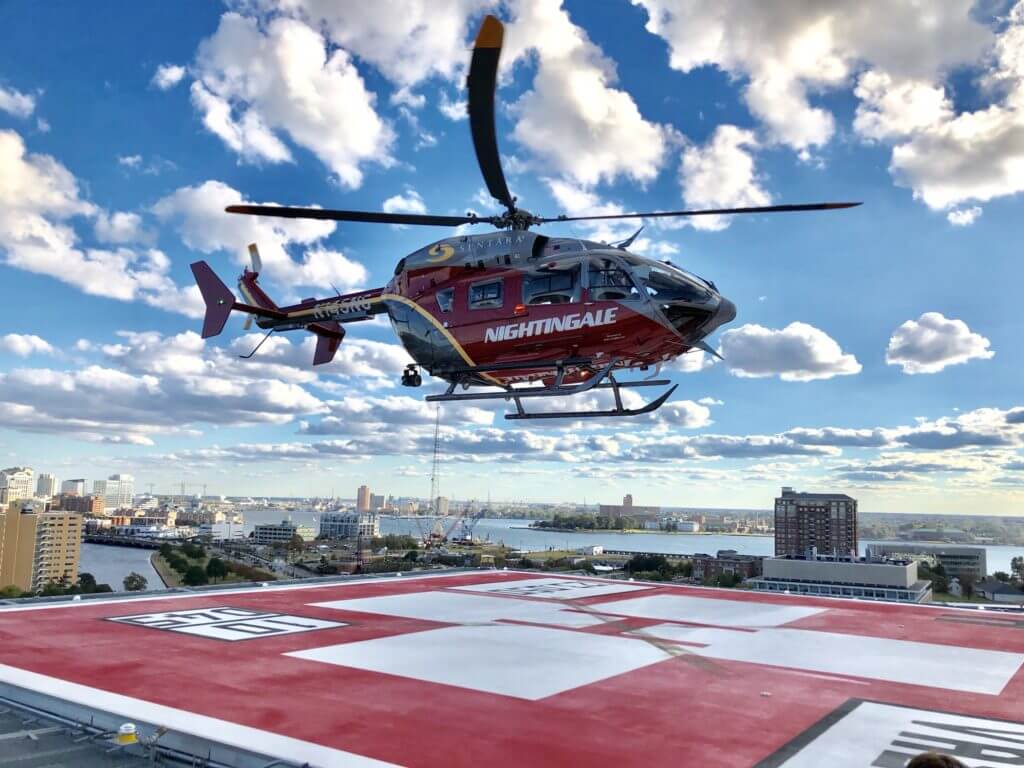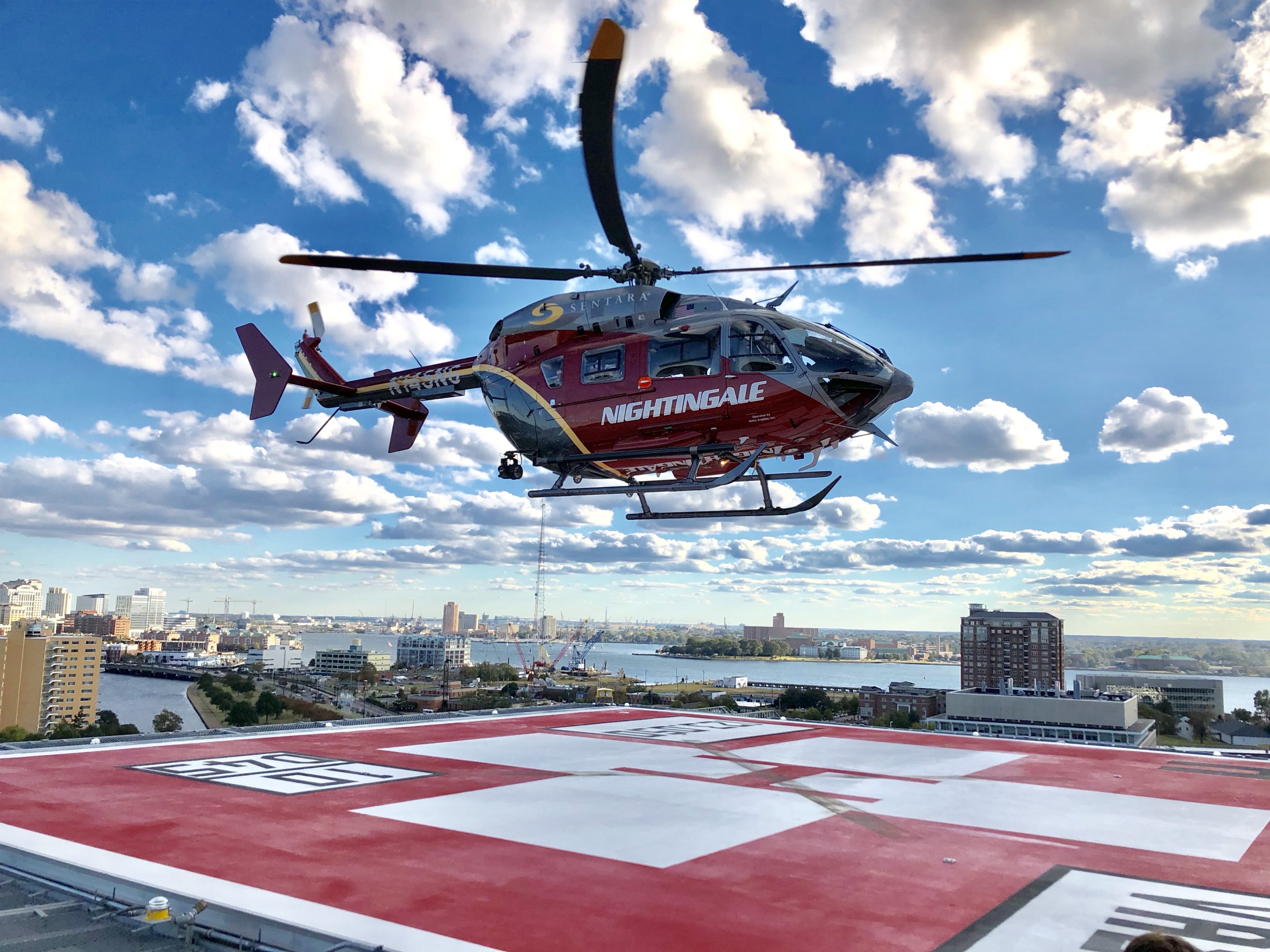Sentara Nightingale Regional Air Ambulance transitioned from its original ground helipad to a rooftop array 296 feet above grade on May 1, 2019. Nightingale is based at Sentara Norfolk General Hospital, a 525-bed Level I trauma and tertiary referral center in Norfolk, Virginia. The Nightingale program has been in operation since February 1982 and currently operates an IFR-capable 2011 Airbus EC145.

The new rooftop site includes a 45-foot by 45-foot pad exclusively for Nightingale and an adjacent 65-foot by 65-foot pad for other air ambulances in the region and U.S. Coast Guard and U.S. Navy MH-60 helicopters, which called at the hospital 21 times in 2018. The visitor pad has a capacity of 22,000 pounds.
“It’s safer for us and the public to take off and land from the roof,” said Denise Baylous, program manager and flight nurse. “The ground pad is flanked by the hospital and a medical office building which creates a swirling effect that buffets the helicopter on windy days.”
There are two ground level pads. The lower one will be converted to ambulance and police parking outside the emergency department (ED). The upper pad will remain for overflow on busy days when the rooftop pads are occupied and a third aircraft needs to land.
The $3.7 million rooftop site, designed and built by FEC Heliports, tops a three-story vertical expansion of the hospital’s Kaufman and River wings. It is a five-year, $200M project scheduled for completion in 2020. The rooftop helipad was originally sequenced for 2020, but a giant million-pound crane, already on site to lift construction materials, inspired project leadership to move up the helipad placement while the crane was still there.
“There has been a learning curve to make the best use of the new configuration,” said Baylous, “This is an exciting evolution for our team and we’re looking forward to using this state-of-the-art system.”
Training for the rooftop system includes invitations to Dare MedFlight and other air ambulances in the region to practice landing and transporting patients to the ED via elevator with help from hospital Security and Nightingale personnel. Coast Guard crews from the air station in Elizabeth City, North Carolina and squadrons from Naval Air Station Norfolk are also being invited to practice landing on the roof and offloading patients.
Baylous started a joint training program with the Navy and Coast Guard in 2014 to optimize communication and safety when military helicopters call at the hospital, which they did 21 times in 2018. They now call Nightingale dispatch on the radio prior to arrival; personnel assisting on the ground are familiar with the configuration of Navy and Coast Guard aircraft and military members are more comfortable with patient handoffs.
One notable challenge of the rooftop project has been the fueling system. The builders had to install underground piping from the ground-level storage tank across the ED parking lot and up the side of the hospital to carry jet fuel to the roof almost 300 feet off the ground. Once they cleared that engineering hurdle, real-life application of the system revealed a need for tweaks to optimize operations. One example: pilots discovered that the square metal edge of the decking had the potential to chafe fueling hoses rolled out of a stainless steel storage box just below deck level. Builders corrected this by cutting a gap down the length of a stainless steel pipe and welding the pipe onto the deck edge to create a rounded surface for fueling hoses to roll over. The new fueling system includes fuel sump separators, allowing for less fuel waste during daily fuel samples.
IFR routes add weather capability
Rooftop landings coincide with adoption of nine Federal Aviation Administration (FAA)-approved instrument flight rules (IFR) routes in eastern Virginia and northeast North Carolina in early 2019. Donations to the Sentara Foundation Hampton Roads helped fund a contract with Hickock & Associates consultants, who mapped the routes and obtained FAA approval over two years.
The IFR sites include two Sentara hospitals in Suffolk and Williamsburg in Virginia, and a third in Elizabeth City, North Carolina, as well as the Outer Banks Hospital in Nags Head and volunteer rescue squad buildings in Corolla and Carova on the North Carolina Outer Banks; a rescue squad in Isle of Wight County, Virginia, on the western edge of Nightingale’s primary service area; and Campbell Field Airport, a general aviation strip on Virginia’s Eastern Shore.
Private donors on The Shore gave the Sentara Foundation $40,000 toward IFR development to ensure rapid access to hospital care across the Chesapeake Bay. Travel by ground across the Chesapeake Bay Bridge-Tunnel to Sentara hospitals in Virginia Beach or Norfolk can take up to 90 minutes. Nightingale flies from Campbell Field Airport to Sentara Norfolk General in 25 minutes.
Nightingale conducted 722 total flights in 2018 — 269 of those, about (30 percent) were to northeast North Carolina.
“We turned down 87 flights to northeast North Carolina last year due to weather,” Baylous said. “We probably could have accepted up to 30 of those flights if we had IFR in place at the time, so we look forward to taking more flights in cloudy weather and better serving our EMS partners and patients.”
A history of service
Nightingale was the first hospital-based helicopter ambulance in Virginia and the 38th air ambulance program in the U.S. when it flew its first mission in February 1982 – an 18-minute flight from Virginia Beach General Hospital – above rush-hour traffic and gridlocked tunnels under the Elizabeth River – to Naval Medical Center Portsmouth, delivering a patient with a cranial bleed.
The program quickly evolved during its first six months from a Bell LongRanger adapted for ambulance use to a purpose-built MBB Bo.105. A few years later, the program purchased a 1986 Eurocopter (now Airbus) BK117. In 2011, after a two-year campaign by the Sentara Foundation Hampton Roads dubbed ‘Saving Minutes, Saving Lives,’ which raised $3.5M toward the $7.2M cost, the program purchased a 2011 Airbus EC145, outfitted with autopilot, night vision, weather radar, obstacle avoidance technology and wire cutters.
“Sentara could have written a check,” said Baylous, “but we wanted to educate the community through the campaign about Nightingale as a life-saving asset that virtually anyone could need one day, and the campaign was well-received.”
Donors included Currituck County, North Carolina, a bi-county EMS organization in northeast North Carolina, the city of Suffolk, Virginia, corporations and foundations and Sentara employees through voluntary payroll deduction.
Sentara owns the aircraft. Metro Aviation operates it. The team complement includes four pilots, six flight nurses with backgrounds in emergency and critical care, and 10 flight paramedics, most of whom are full-time cross-trained firefighters, plus two Metro mechanics.
The program has never made money. It operates at an annual deficit approaching seven figures as part of the Sentara not-for-profit mission.
Safety first
The Nightingale program is in its 37th year of operation with more than 22,000 missions completed without a reportable incident. The focus on safety involves active participation by the clinical team in aircraft operations. Nurses and paramedics take turns riding with the pilot outbound to keep an external watch and monitor weather radar and radio traffic. In-flight conversation is mission-focused.
Decisions on accepting flights are collaborative. “It’s three to go and one to say no,” said pilot Scott Nance. “We have trained and worked together for many years and trust each other’s instincts. If somebody doesn’t feel right, we discuss it. Everyone on this team is encouraged to speak up if they have concerns. Our utmost goal is the safety of the patient and our team.”
Nightingale pilots try not to know too much about what’s going on in the back. “My charge is getting the aircraft there and back in one piece,” said John Stanley, a 30-year Nightingale pilot. “I don’t want the patient’s issues to affect my judgement or tempt me to deviate from our safety parameters.”
Baylous often describes Nightingale to the public as a flying ICU. “Whatever you can do in a hospital ICU, we can do in flight,” she said. People seem to get that. With a new rooftop helipad and IFR capability, the Sentara Nightingale program continues to evolve with an unwavering commitment to the Sentara Healthcare mission to improve health every day.









